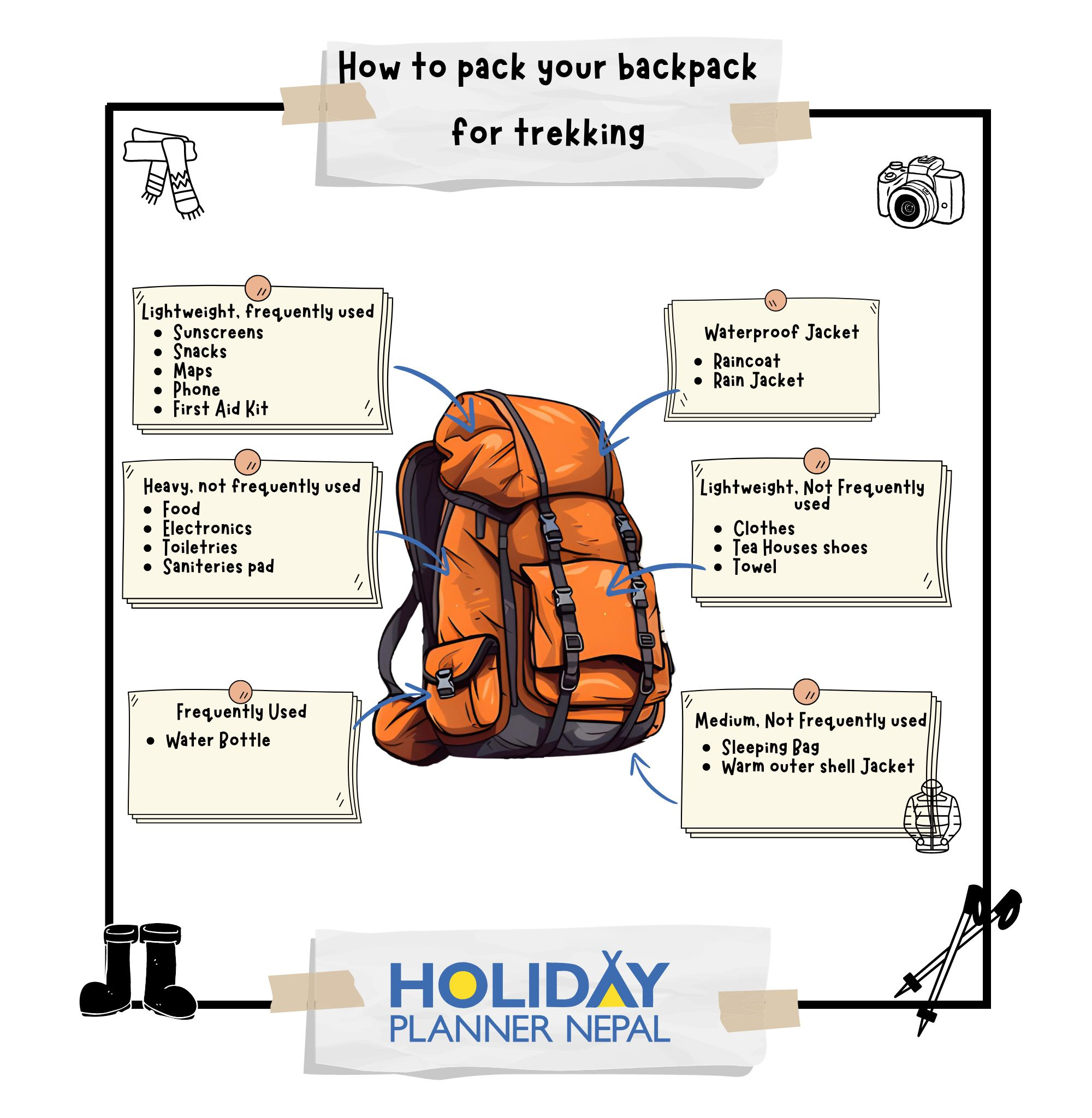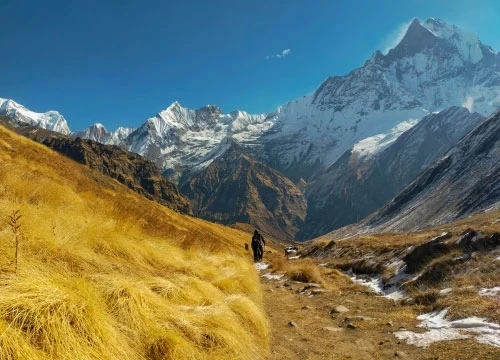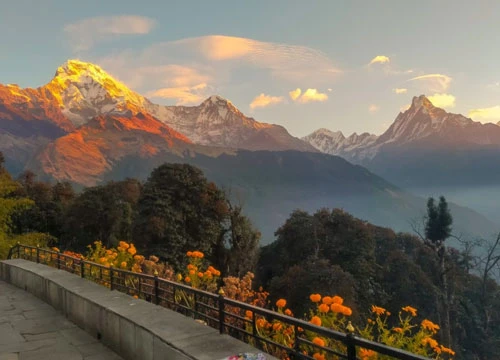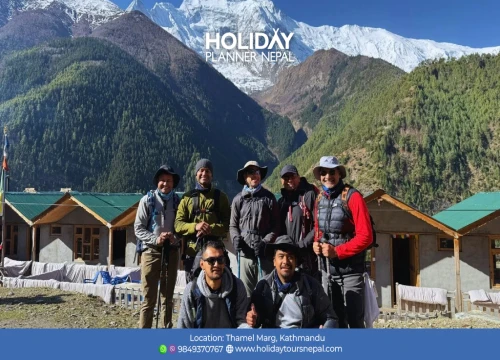Nar Village
The Nar village is a beautiful yet remote village located in the Manang district at an elevation of 4,150 meters. The Nar village is located inside the Annapurna Conservation Area. The Nar indigenous people inhabit it with their unique culture and tradition. Visiting the Nar village is like walking back in time, where ancient rituals, festivals, and ceremonies occur. The structure of the town reminds me of the traditional royal setting. The Nar village route is off-beaten, filled with Buddhist Gompas, Mani Walls, and religious Buddhist structures, giving life to the region's rich cultural tapestry.
Phu village
The Phu village, which is also settled in the Annapurna Conservation Area, is another popular and attractive destination in the Manang district. The Phu village, at an elevation of 4050 meters, is a living museum of preserved ancient culture, monasteries, festivals, and traditions. The town provides a magnificent view of Mt Annapurna and Mt Manaslu while giving insights into Buddhist rituals and festivals in the festive season.
Highlights of Nar Phu village Trek
- Adventure on hidden areas with north of massive Annapurna and South of Damodar Himal Amazing experience on daily walks with the magnificent panorama of mountains with scenic terrain.
- Starting from low warm paddy fields to alpine zone and at arctic fields of ice and glaciers.
- Beautiful woodland of tall rhododendron and fir trees to an arid country with alpine bushes.
- Into wild north at Nar & Phu the hidden Shangri-la away from mainstream trekking trails.
- Picturesque scenery of upper Manang with Nar-Phu villages and crossing scenic Kang-La pass.
Some Key Points of Nar Phu Valley with Annapurna Circuit Trek (17 Days)
Total Duration: 17 Days
Trek Region: Nar Phu Valley and Annapurna Circuit, Western Nepal
Maximum Elevation: Kang La Pass – 5,322 m / 17,460 ft
Trek Difficulty: Strenuous
Starting Point: Koto (after drive from Kathmandu via Besi Sahar)
Ending Point: Muktinath (drive back to Pokhara)
Best Seasons: Spring (March–May) and Autumn (September–November)
Acclimatization Days: Phu Village & Manang
Accommodation: Teahouses/lodges in trekking route
Transportation: Overland drive to Koto; return by drive/fly from Muktinath to Pokhara/Kathmandu
Cultural Experience: Unique Tibetan-influenced Buddhist culture in Nar and Phu villages
How does the Nar Phu Village trek start and end?
Nar Phu Valley Trekking starts from Kathmandu with an enjoyable overland drive that leads around Nepal's North Mid-West Himalayas. Walking from low, warm paddy fields and terraces via Besi Sahar, the journey heads higher towards an alpine cooler zone covered with lovely coniferous woods with daily views of peaks to Koto.
For some time, the adventure leads on the popular and scenic Annapurna Circuit trail. The route from Besi Sahar transcends to Dharapani while reaching the small village of Koto. After Koto, the route of Annapurna Circuit diverges, and we follow the road towards the Nur Phu village. Along the way, trekkers cross prominent villages like Meta, and Kyang and then head towards beaten tracks into hidden areas at Nar-Phu villages, spending a grand time visiting its withered towns and landscapes. A trek to Nar Phedi and Nar Goan follows the trek to Phu village.
After Nar-Phu, travelers cross the high scenic Kang-la pass to enter Manang Valley and its main village at Manang on the main trekking trails of the Annapurna circuit with Tilicho Lake; after Manang village, the adventure then crosses the highest pass of the whole trip that is over the Thorang-la at 5,416 m high.
Slowly, the walk comes to an end after Thorang-la heads towards the holy Muktinath Temple areas within the Mustang region. The Muktinath temple is a Hindu temple that is considered one of the world's highest temples, where 108 waterspouts and two kundas are located. Bathing in the waterspouts and kundas is believed to wash away human sins. The popular time to visit Muktinath is during the festival of Janai Purnima (Full moon in August).
After the exploration, the tour commences with a panoramic short drive to picturesque Lakeside Pokhara, a famous tourist place in the whole Himalaya region facing Annapurna Himalaya that reflects on its calm Phewa and Begnas Lakes.
Our incredible journey of Nar Phu Valley Trekking was completed with an exciting drive back to Kathmandu from Pokhara, fond memories, and a wonderful time beyond Annapurna Massifs and Manang Valley.
Nar Phu valley trekking - 17 Days altitude and distance chart
Day | Activity | Altitude (m/ft) | Distance (km/miles) | Duration (hours) | Elevation Gain/Loss |
01 | Arrival in Kathmandu and transfer to the hotel | 1,350 m / 4,430 ft | — | — | — |
02 | Drive to Koto via Besi Sahar | 2,600 m / 8,530 ft | ~170 km / 105 miles | ~8-9 hrs drive | +1,250 m / +4,100 ft (drive) |
03 | Trek to Meta | 3,570 m / 11,713 ft | ~16 km / 9.9 miles | ~6 hrs walk | +970 m / +3,182 ft |
04 | Trek to Kyang | 4,100 m / 13,451 ft | ~12 km / 7.5 miles | ~6 hrs walk | +530 m / +1,738 ft |
05 | Trek to Phu Village | 4,080 m / 13,386 ft | ~13 km / 8 miles | ~6 hrs walk | -20 m / -66 ft |
06 | Rest day and exploration around Phu Village | 4,080 m / 13,386 ft | ~5-6 km / 3-4 miles | ~3 hrs walk | Minimal |
07 | Trek to Nar Phedi | 3,545 m / 11,630 ft | ~14 km / 8.7 miles | ~6 hrs walk | -535 m / -1,755 ft |
08 | Trek to Nar-Gaon | 4,110 m / 13,484 ft | ~9 km / 5.6 miles | ~6 hrs walk | +565 m / +1,854 ft |
09 | Exploration of Nar Village and visit monasteries | 4,110 m / 13,484 ft | ~3-5 km / 2-3 miles | ~3 hrs walk | Minimal |
10 | Trek to Kang La Pass and descend to Ngawal | 5,322 m / 17,460 ft 3,660 m / 12,008 ft | ~16 km / 9.9 miles | ~7-8 hrs walk | +1,212 m / +3,975 ft |
11 | Trek to Manang | 3,540 m / 11,614 ft | ~10 km / 6.2 miles | ~5 hrs walk | -120 m / -394 ft |
12 | Trek to Yak Kharka | 4,110 m / 13,484 ft | ~10 km / 6.2 miles | ~4 hrs walk | +570 m / +1,870 ft |
13 | Trek to Thorang High Camp | 4,600 m / 15,092 ft | ~7 km / 4.3 miles | ~4 hrs walk | +490 m / +1,608 ft |
14 | Cross Thorong-La Pass and descend to Muktinath | 5,416 m / 17,769 ft 3,800 m / 12,467 ft | ~16 km / 9.9 miles | ~7-8 hrs walk | +816 m / +2,677 ft |
15 | Trek to road head and drive to Pokhara | 820 m / 2,690 ft | ~90 km / ~56 miles (drive) | ~6-7 hrs (drive) | -2,980 m / -9,777 ft (drive) |
16 | Drive or fly to Kathmandu | 1,350 m / 4,430 ft | ~200 km / ~124 miles (drive) | ~6 hrs drive | +530 m / +1,740 ft (drive) |
17 | Final international departure | — | — | — | — |
What is the best time/season for starting the Narphu valley trek?
The Nar Phu Valley trip can be made at any time of the year in Nepal. The Narphu trekking destination is open year-round. However, spring and autumn are the best time or season to embark on Narphu Valley.
Spring season
Spring, which lasts from March to May, is one of Nepal's best seasons to trek. Moderate temperatures and clear skies accompany the spring days. The walking time is longer due to the more extended day length. The atmosphere is beautiful, with blooming rhododendron and alpine forests.
Average temperature can range from 10°C to 20°C (50°F to 68°F) with nighttime around -3°C.
Autumn Season
Autumn, which lasts from September to November, is another best season for trekking in Nepal. Autumn days are less crowded than in spring. Thus, the trekking trails are more comfortable and peaceful. The forests are filled with seasonal fruits with unique and sweet aromas. Similarly, the autumn days cover moderate temperatures, which aid in the comfortable travel experience. The landscapes are undisturbed as the skies are clear.
The average temperature ranges from 8°C (46.4°F), with nighttime around -6°C.
Winter Season
Winter, which lasts from December to February, is not a recommended season to travel to Nurphu village. Due to its challenging aspects, this season is considered an off-season for Trekking in Nepal. The winter season is only recommended for expert or hardcore trekkers. The weather is unpredictable in winter, with temperatures ranging below freezing point. This extreme temperature comes with high-velocity wind, snow, and slippery trails, causing extra trouble for walkers. The view can be disturbed due to the heavy snow and cloudy sky. Thus, trekking in winter requires additional preparation with complete guidance and support.
Summer Season
Summer, which lasts from June to August, is considered a monsoon period in Nepal. In summer, the Narphu Valley lies in the rain shadow area. Thus, the chances of rainfall are pretty low—amazing scenery accumulated with dry trails and beautiful landscapes. The summer season can be an excellent option for traveling to Nar Phu.
Why travel to Narphu Valley? Why is Narphu Valley trekking special?
Narphu, located in the remote Annapurna region, is a hidden gem for travelers. The unique blend of natural beauty, cultural heritage, and rich religious history makes Narphu one of Nepal's most recommended travel destinations. Those who seek to travel alone, in groups, or with family members are welcomed by the rich Tibetan culture of the Narphu region. Some of the specialties of Narphu Valley are as follows:
- The trek offers a breathtaking view of the Annapurna and Manaslu mountain ranges with varying landscapes, including desert-like high altitudes and lush green valleys in the lower regions.
- The Nar and Phu villages are home to the Tibetans, with routes comprising ancient monasteries, chortens, and rich cultural heritage.
- The off-beaten path of the trekking route can be ideal for slow and comfortable walkers who wish to trek to unique locations and underdeveloped trails with a feel of authentic Trekking.
- The Annapurna Circuit, or Annapurna Sanctuary, allows visitors to witness some of the exotic and rare animals of the region.
- The Nar Phu Valley tour provides stunning views of snow-capped mountain peaks like Pisang Peak, Chulu East, and Chulu West with glacier views of Himlung Himal Glacier, Gangapurna Glacier, Tilicho Glacier, and Pisang Glacier.
Is Nar Phu valley trek difficult?
The Nar Phu Valley trek is considered a moderately difficult trek. The trekking experience can get pretty hard during long walks and steep altitude ascents. The trekking route of Nar Phu village consists of an elevation from 2,600 meters to the highest elevation of 5,240 meters in Kang La Pass. This elevation gain can be difficult for beginners at trekking or those who have yet to have trekking experience. However, for those who have already experienced high-altitude trekking, the Narphu Valley trekking difficulty is considered easy.
Acute Mountain Sickness (AMS), or altitude sickness due to decreased oxygen levels, is possible. However, avoiding rapid ascent or hefty walking with proper acclimatization can help reduce the chances of altitude sickness. Going slow with adequate hydration and an easy uphill walk is the key to avoiding AMS or completing the trek with ease.
The difficulty of the trek also depends on the season or time of travel. Therefore, it is recommended to trek in the recommended season to avoid any unforeseen activities. It is also necessary to understand that Nar Phu Trekking is a comparatively easy trekking destination compared to the Everest Base Camp Trek or Annapurna Base Camp trek. So, Holiday Tours Nepal is here to properly customize your Nar Phu Valley Trekking Itinerary as per your personal choice and fitness level to provide a safe, comfortable, and hassle-free walking experience.
How to prepare for Nar Phu valley trekking?
Preparation for trekking is crucial for a safe and enjoyable Nar Phu Valley trekking experience. Consider the following measures to get ready for the experience:
Physical Fitness
Walking in a remote area can be strenuous. Thus, it is necessary to stay physically fit before heading towards the trek. The lengthy walk can be tiring and hectic, so engaging in cardiovascular exercise at least one-month before trekking is necessary. Trekkers can engage in walking, jogging, swimming, running, and cycling exercises for physical fitness. Some minor changes that can be made in daily activity are avoiding lifts and taking stairs, having a proper hydration schedule, carrying about 40-45 kilos/88-99 pounds, walking at least 45 minutes per day, and so on.
Mental fitness
Besides physical fitness, mental fitness is also required for trekkers. As the Nar Phu village is located on the remote side of Nepal, expect something other than luxury here. The accommodation options are minimal, with basic facilities. The foods are locally prepared, and taste may differ in comparison to an individual's daily meal. There can be various minor changes in the daily routine due to the time and season of travel followed by tiring long walks. All these reasons can cause irritation and dissatisfaction, which ultimately affects the trekking experience. Thus, keep an open mind, not getting irritated with minor changes, and getting satisfied with availability rather than being stubborn with the choice.
Acclimatization
Altitude sickness is caused due to improper acclimatization. So, following the proper acclimatization techniques is necessary while ascending to the high-altitude region. Following the mountain guide and spending a few days acclimating before ascending to the high altitude is crucial. Short walks to higher altitudes while spending some time and then returning to the lower altitude will help adapt to the higher elevation's decreased oxygen level.
Research on the area
While our guides are experts and native to the region, we recommend travelers to do some background study about the place they are visiting. This will enable them to understand the landscapes, diversity of culture, and what to do. And what not to do? Food and accommodation options, and many more. After gaining knowledge about these things, they would have similar expectations without getting floored by sudden changes.
Accommodations in Nar and Phu village
There are a variety of accommodation options in the Nar Phu Valley. The options range from basic teahouses to more standard guesthouses and hotels. A brief description of the accommodations is as follows:
- Teahouses: They are the basic accommodation options that provide regular bed and blanket facilities. The teahouses are all along the Nar Phu Valley trekking map, the only available options at high altitudes. Teahouses might be compromised with shared bathrooms; however, they provide comfortable rooms for trekkers to spend the night. A room in a teahouse has two single beds or one double bed, which can accommodate only two individuals.
- Guesthouses and hotels: these are the standard types of accommodation as compared to the teahouses. They provide basic bed and blanket facilities with other amenities. The bathrooms are attached with adequate heating systems. Electric blankets are available here, which offer a cozy atmosphere to rest in. Similarly, staying in a guesthouse or hotel offers the opportunity to interact with the locals and understand the way of life in the Nar Phu region. A room in the guesthouse consists of two beds for two individuals. They work on a one-individual, one-bed basis.
How is the electricity, charging, communication (Wi-Fi), and shower facility at Narphu valley?
- Electricity: As the Narphu Valley trek is considered a remote trek, there can be sudden power cuts in some places of the trek. However, it is rare. Electricity is available in central locations and can be used accordingly. Solar is mostly installed for visibility and electricity in the area of power cuts.
- Charging: Charging is one of the most crucial factors while trekking. Charging can be done in teahouses, guesthouses, or places of accommodation. However, the cost of charging must be paid according to the use. The charging station in the teahouse is in the lobby, where trekkers take turns charging their devices, whereas ports for charging are available inside the rooms of guesthouses and hotels. It is recommended to take extra batteries, solar chargers, or power banks to charge the electric devices to reduce the cost of charging.
- Communication (Wi-Fi): Individuals tend to communicate with their loved ones during the trek. So, carrying a Nepalese SIM card is necessary to do so. Holiday Planner Nepal provides fellow trekkers with a sim card, which enables them to communicate during their stay in Nepal. Similarly, the sim card also has 28 GB of data, which will be enough for a 17-day Nar Phu Valley trekking package. One can get a more robust Wi-Fi network in an accommodation place, but the cost can be extra.
- Shower: there are mainly two types of shower options: cold showers and another is hot showers. The shower can be done in the place of accommodation. Within the hot shower also, there are three types of hot showers: bucket showers, geyser showers, and solar hot showers. While accommodations do not provide all these shower facilities, one may have one type and not another. Hot showers cost extra in the accommodation option.
What are the food options at Narphu Valley?
- Breakfast: Tibetan Breads, Chapati with Cheese (dry bread and cheese), Oatmeal, French Toast with jam and honey, Hashed brown, French fries, eggs (scrambled or boiled), pancakes, muesli, vegetables including peas and potatoes.
- Lunch: Dal Bhat Tarkari (Rice, Lentil soup, and mixed vegetables), Mo: Mo (Dumplings), Tibetan/chapatti bread, Macaroni and pasta, Spaghetti, Sherpa Stew, Pizza, Rice and curry, Spring rolls, Burgers, Steak, Soups and Potatoes.
- Dinner: Mo: Mo, Thukpa, Dal Bhat, Chapatti Bread, Macaroni, Spaghetti, Sherpa Stew, Variety of Soups, Steaks, Potatoes, Sandwiches, Macroni and pasta, Sandwiches, Pizza, Spring rolls, Ramen, Burgers, Steaks and others.
- Beverages: The drink option ranges from alcoholic to non-alcoholic drinks. While alcoholic beverages are strictly not recommended as they cause dehydration, some of the non-alcoholic drinks are Black/Milk Coffee (drinking too much can cause dehydration), black/milk/mint/ginger/green/honey tea, hot chocolates, mango juice, orange juice, pineapple juice, apple juice and other varieties of fruit juices.
What are the permits required to enter the Narphu Village?
As Narphu village lies under a restricted or protected area, various permits are required to enter this fantastic village according to the regulations of the Government of Nepal.
The permits for Narphu Village trekking are:
- Nar Phu Valley Restricted Area (NRA) Permits
- Annapurna Conservation Area Permit (ACAP)
- Trekkers Information Management System (TIMS) card
The above-mentioned permits can be obtained with the help of authorized trekking companies like Holiday Tours Nepal.
What are the chances of Altitude Sickness on the Narphu Village trek?
Altitude sickness is also known as Acute Mountain Sickness (AMS). AMS is a common problem for high-altitude trekkers. AMS is caused due to the lack of oxygen levels in higher elevations, which causes difficulty in breathing and walking.
The common symptoms of AMS
- Dizziness
- Difficulty in Sleeping
- Fatigue
- Headache
- Shortness of breath
- Loss of Appetite
- Nausea and Vomiting
- High Pulse rate
Some complications of AMS
High Altitude Pulmonary Edema (HAPE): This is one of the severe forms of acute mountain sickness. In case of HAPE, the blood vessels in the lungs constrict to increase pressure, thereby causing the fluid to leak from the blood to the lungs.
High Altitude Cerebral Edema (HACE): It is a rare, however life-threatening complication of altitude sickness. During HACE, the capillaries in the brain cause it to swell.
Precautions for Acute Mountain Sickness
- It is essential to acclimatize while taking frequent days of rest properly. It is necessary to gain up to 300-500 meters of elevation per day and ascend slowly.
- Proper hydration is another way to prevent altitude sickness. Drinking fluids needed for the body while omitting alcoholic drinks and smoking can help to reduce AMS.
- It is necessary to descend quickly once the symptoms of altitude sickness are recognized. Do not ascend if the first sign of AMS is seen.
- Report immediately to your guide in case of difficulty while walking or breathing. Your guide will be your partner, who will help you overcome altitude sickness.
- Improve your physical and mental fitness before embarking on the trekking trail.
- Gain knowledge about AMS, its symptoms, and prevention methods to recognize them and take necessary action against them.
- Eat plenty of garlic soups and consult with a medical professional before taking any medicines to reduce the chances of AMS.
Is travel insurance required for trekking in Narphu Village?
While travel insurance is not mandatory to buy to travel to Narphu village, having travel insurance can help to safeguard against various unforeseen circumstances. We recommend buying travel insurance from a verified insurance company with a good policy. The following points must be covered from insurance.
- Medical emergency and evacuation: Ensure that the policy provides compensation for medical expenses, including medical treatment and evacuation.
- Trip Cancellation or interruption: The trip can be canceled or interrupted due to various reasons, which can be personal or natural, like avalanches, heavy snowfall or others.
- Lost or stolen items: theft is uncommon; however, be sure to purchase insurance, which compensates for lost or misplacement of belongings.
- Emergency assistance: Look for the policy, which includes assistance in case of emergency. Be sure to buy the one that provides 24/7 assistance.
- Physical injury: Be sure to buy travel insurance to compensate for medical bills in case of bodily injury.
Nar Phu valley trek outline itinerary
Day 01: Arrival in Kathmandu 1,350 m / 4,430 ft and transfer to hotel.
Day 02: Drive to Koto via Besi Sahar (760 m/2,490 ft) 8-9 hrs. drive
Day 03: Trek to Meta (3570m) - 06-07 hours walk
Day 04: Trek to Kyang 4,100 m - 6 hrs.
Day 05: Trek to Phu village 4,080 m - 06 hours.
Day 06: Rest Day at Phu village visit around Phu village and the valley
Day 07: Trek to Nar Phedi 3,545 m - 06 hrs.
Day 08: Trek to Nar-Gaon (4,110m / 13,484ft) - 06 hrs.
Day 09: Visit Monasteries in Nar Village.
Day 10: Trek from Nar (4,110m / 13,484ft) to Kang La Pass (5,322m / 17,460ft) to Ngawal (3,660m / 12,008ft)
Day 11: Trek to Manang 3,540 m - 05 hrs.
Day 12: Trek to Yak Kharka 4,110 m - 04 hours.
Day 13: Trek to Thorang High Camp 4,600 m - 04 hrs.
Day 14: Cross Thorang-La 5,416 m and to Muktinath 3,800 m - 07 hrs.
Day 15: trek to the road ahead and drive back to Pokhara
Day 16: Drive / Fly to Kathmandu - 06 hrs. journey (30 mins via air)
Day 17: Final International departure from Nepal.

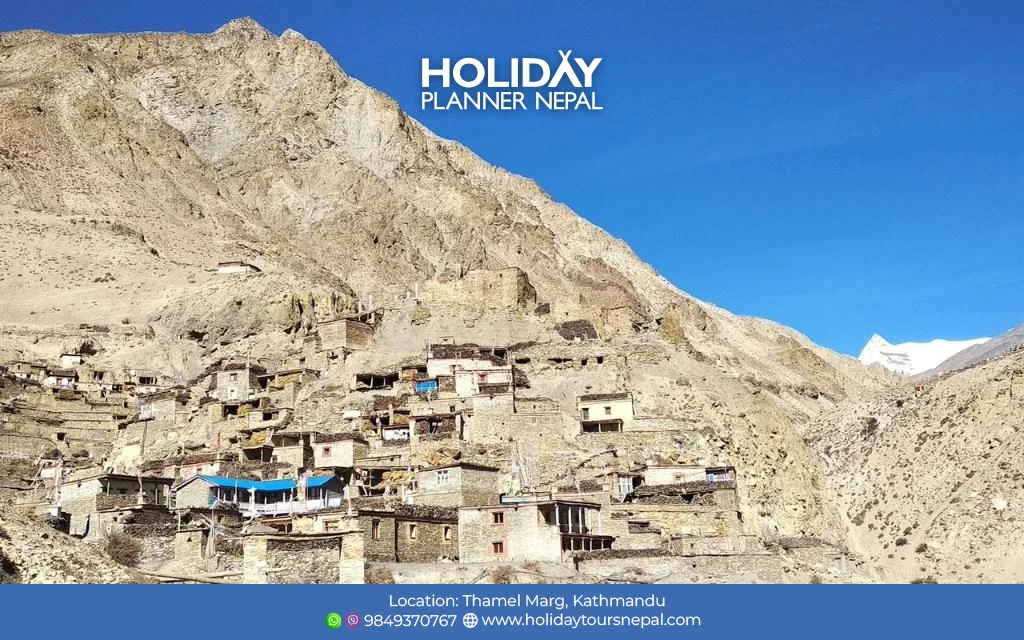
 General
General Upper Body
Upper Body Torso
Torso Lower Body
Lower Body Hands
Hands Feet
Feet Undergarments and Inner Wears
Undergarments and Inner Wears First Aid Kits and Medications
First Aid Kits and Medications Other Essentials
Other Essentials